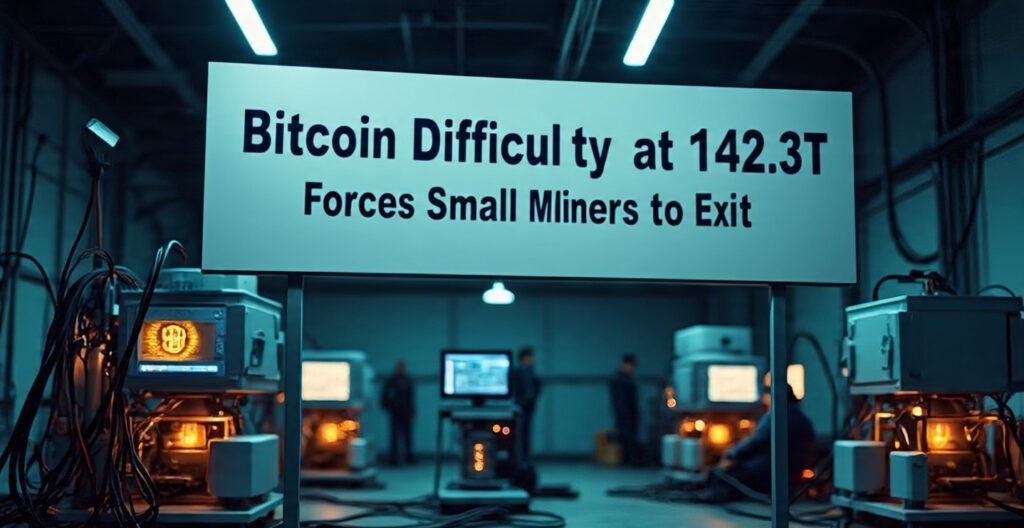The Bitcoin network has reached a new milestone with its mining difficulty soaring to an unprecedented 142.3 trillion (142.3T), marking one of the most significant adjustments in the cryptocurrency’s history. This dramatic increase represents a fundamental shift in the Bitcoin Mining landscape, creating ripple effects that extend far beyond simple technical metrics. As the network’s computational requirements reach new heights, small-scale miners find themselves facing an increasingly challenging environment that threatens their operational viability.
Bitcoin difficulty serves as the network’s self-regulating mechanism, automatically adjusting approximately every two weeks to maintain the target block time of 10 minutes. When more miners join the network or existing miners upgrade their equipment, the difficulty increases proportionally to ensure consistent block production. The current surge to 142.3T represents not just a number, but a reflection of the intense competition and substantial capital investment flowing into Bitcoin Difficulty mining operations worldwide.
This escalation has profound implications for the mining ecosystem, particularly affecting smaller operations that lack the economies of scale necessary to compete with industrial-grade mining farms. As mining profitability becomes increasingly dependent on access to cheap electricity, cutting-edge hardware, and substantial capital reserves, many individual miners and smaller operations are being forced to reconsider their participation in the network. The phenomenon represents a natural evolution of the Bitcoin network toward greater centralization among well-capitalized mining entities.
What is Bitcoin Mining Difficulty?
Bitcoin mining difficulty represents the measure of how challenging it is to find a new block compared to the easiest it could ever be. The Bitcoin protocol automatically adjusts this difficulty level every 2,016 blocks (approximately every two weeks) to maintain the average block time at 10 minutes. When the combined computational power of all miners increases, the difficulty rises proportionally to keep block production steady.
The difficulty adjustment algorithm examines the time taken to mine the previous 2,016 blocks. If blocks are mined faster than the target 10-minute interval, the difficulty increases. Conversely, if mining took longer than expected, the difficulty decreases. This self-regulating mechanism ensures the Bitcoin Difficulty blockchain maintains its predictable issuance schedule regardless of how much mining power is dedicated to the network.
The Mathematics Behind 142.3T Difficulty
The current mining difficulty of 142.3T means that miners must perform approximately 142.3 trillion hash calculations on average to find a valid block hash. This astronomical number reflects the cumulative effect of continuous network growth and the deployment of increasingly powerful mining equipment. To put this in perspective, the difficulty has increased by over 500% in the past three years alone.
Hash rate and difficulty share a direct relationship. As the total network hash rate increases, indicating more computational power securing the network, the difficulty adjusts upward. The current difficulty level corresponds to a network hash rate of approximately 1,015 exahashes per second (EH/s), representing an enormous amount of specialized computing power dedicated solely to Bitcoin mining.
Impact on Small-Scale Mining Operations
Economic Pressures on Individual Miners
Small-scale miners face unprecedented challenges at the current difficulty level. The increased computational requirements mean that older mining equipment, particularly ASIC miners with efficiency ratings below 30 J/TH (joules per terahash), is no longer profitable under most electricity cost scenarios. Many home miners who entered the space during previous bull markets are discovering that their operations are no longer economically viable.
The break-even point for mining has shifted dramatically upward. Miners now require access to electricity costs below $0.08 per kWh to maintain profitability with mid-range equipment, while premium locations with industrial power rates below $0.04 per kWh are becoming essential for competitive operations. This requirement effectively excludes residential miners in most developed countries where electricity costs typically exceed these thresholds.
Equipment Obsolescence and Upgrade Pressures
The current mining difficulty surge accelerates equipment obsolescence, forcing miners to continuously upgrade to more efficient hardware. ASIC miners that were profitable just months ago are now struggling to cover operational costs. The latest generation miners, such as the Antminer S21 series with efficiency ratings around 17.5 J/TH, represent the new baseline for competitive mining.
Capital requirements for maintaining competitive mining operations have increased exponentially. A single state-of-the-art ASIC miner can cost $3,000-$8,000, and achieving meaningful mining rewards requires multiple units. Small miners face the difficult choice between substantial capital investment in new equipment or ga raceful exit from mining operations.
Large-Scale Mining Dominance
Industrial Mining Operations Take Center Stage
Large-scale mining operations benefit significantly from economies of scale at the current difficulty level. Industrial mining farms negotiate bulk electricity contracts, often securing rates below $0.03 per kWh, while also accessing wholesale pricing on mining equipment. These operational advantages become increasingly crucial as mining margins compress under higher difficulty conditions.
Mining pools operated by large entities continue to consolidate hash rate share. The top five mining pools now control over 75% of the network’s computational power, raising ongoing concerns about mining centralization. This concentration reflects the natural economic forces driving the industry toward larger, more efficient operations.
Geographic Distribution of Mining Power
Bitcoin mining has become increasingly concentrated in regions with abundant, cheap energy and favorable regulatory environments. Countries like Kazakhstan, Russia, and certain U.S. states have emerged as major mining hubs, attracting industrial-scale operations seeking competitive advantages. The current difficulty level amplifies these geographic advantages, making location selection critical for profitable operations.
 Energy-intensive mining operations gravitate toward areas with surplus renewable energy capacity, including hydroelectric facilities in regions like Sichuan, China (historically), and volcanic geothermal energy in countries like El Salvador. These locations offer the combination of low electricity costs anda reliable power supply necessary for 24/7 mining operations.
Energy-intensive mining operations gravitate toward areas with surplus renewable energy capacity, including hydroelectric facilities in regions like Sichuan, China (historically), and volcanic geothermal energy in countries like El Salvador. These locations offer the combination of low electricity costs anda reliable power supply necessary for 24/7 mining operations.
Network Security and Decentralization Concerns
Enhanced Security Through Higher Hash Rate
The elevated mining difficulty reflects a more secure Bitcoin network. Higher computational requirements make the network more resistant to potential attacks, as malicious actors would need to control an enormous amount of computing power to attempt network manipulation. The current hash rate represents the highest level of security in Bitcoin’s history.
Network resilience improves as difficulty increases, making 51% attacks increasingly impractical and expensive. The computational cost of attacking the Bitcoin network now exceeds the GDP of many small countries, providing unprecedented security for the world’s largest cryptocurrency network.
Centralization Challenges
Despite enhanced security, the mining difficulty surge raises legitimate concerns about mining centralization. As small miners exit the ecosystem, hash rate concentration among large players increases. This trend potentially conflicts with Bitcoin’s founding principles of decentralization and censorship resistance.
Mining pool concentration presents additional centralization risks. While individual miners may be distributed globally, the pools they join to combine their computational power are controlled by relatively few entities. The current difficult environment may accelerate this trend as smaller pools struggle to remain competitive.
Future Outlook and Industry Adaptation
Technological Innovation in Mining
The mining industry continues evolving in response to increasing difficulty levels. Next-generation ASIC technology promises improved efficiency ratios, potentially reaching sub-15 J/TH performance. These advances may help maintain mining accessibility for smaller operations while pushing the boundaries of computational efficiency.
Immersion cooling and other advanced thermal management solutions are becoming standard in professional mining operations. These technologies enable higher equipment density and improved performance, helping miners maximize returns from limited space and capital investments.
Alternative Mining Strategies
Cloud mining services have gained popularity among individuals seeking Bitcoin mining exposure without direct equipment ownership. These services allow participants to rent mining capacity from large-scale operations, potentially providing access to industrial-grade efficiency without substantial capital investment.
 Mining-as-a-Service (MaaS) models are emerging, where professional mining companies manage equipment on behalf of investors. These arrangements provide exposure to mining returns while leveraging professional expertise and economies of scale to remain competitive at current difficulty levels.
Mining-as-a-Service (MaaS) models are emerging, where professional mining companies manage equipment on behalf of investors. These arrangements provide exposure to mining returns while leveraging professional expertise and economies of scale to remain competitive at current difficulty levels.
Regulatory and Environmental Considerations
Environmental Impact of Increased Mining Activity
The rising mining difficulty corresponds to increased global energy consumption for Bitcoin mining. Environmental concerns continue shaping regulatory responses and industry practices. Many mining operations are transitioning toward renewable energy sources to address sustainability concerns while potentially reducing operational costs.
Carbon footprint considerations are driving innovation in mining practices. Operations utilizing stranded renewable energy or waste gas from industrial processes are becoming more common, addressing environmental concerns while maintaining economic viability.
Regulatory Landscape Evolution
Government responses to Bitcoin mining vary significantly across jurisdictions. Some regions actively court mining operations through favorable regulations and cheap energy, while others impose restrictions or outright bans. The current difficulty level may influence regulatory approaches as the economic significance of mining operations becomes more apparent.
Tax implications for mining operations become more complex at higher difficulty levels. Professional mining operations must navigate depreciation schedules for expensive equipment, while individual miners may face different tax treatment depending on their jurisdiction and scale of operations.
Conclusion
The surge in Bitcoin Difficulty mining difficulty to 142.3T represents a pivotal moment in the cryptocurrency’s evolution. While this increase demonstrates the network’s growing security and adoption, it simultaneously creates significant challenges for small-scale miners who lack the resources to compete in an increasingly professional landscape. The trend toward larger, more efficient operations appears likely to continue as the network matures.
Mining centralization concerns must be balanced against the enhanced security provided by higher difficulty levels. The Bitcoin Difficulty community continues grappling with these tradeoffs as the network evolves beyond its early decentralized ideal toward a more industrial model. Future technological innovations and regulatory developments will play crucial roles in shaping the mining landscape.
For prospective miners, the current environment demands careful analysis of electricity costs, equipment efficiency, and capital requirements. Small players seeking to remain in the mining ecosystem may need to explore alternative strategies such as pool mining, cloud mining services, or collaborative arrangements that provide access to economies of scale previously available only to large operators.

